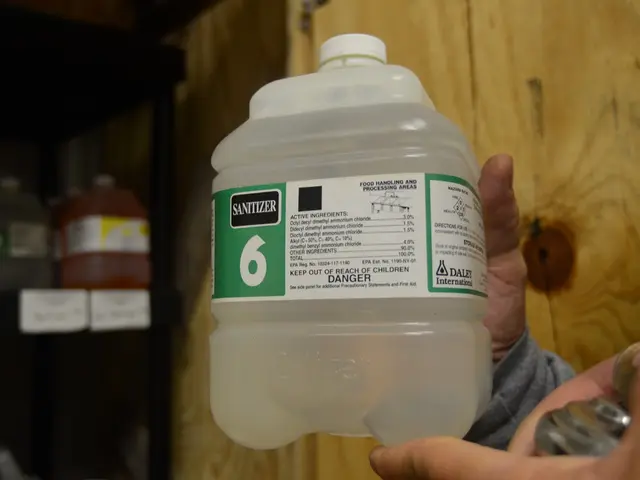A Potato Crisis looms: Cicadas and Stolbur disease ravage south German farms, putting local production at risk
European Union's Status Examined in Commission's Latest Publication
Talk about a real bugger of a problem! Farmers in southern Germany have been finding their potatoes, sugar beets, and even onions becoming soft. The culprit? A plant disease called Stolbur, spread by the reed glass-winged cicada. This little insect hasn't just been targeting farmlands, it's been wreaking havoc, causing significant losses, even total losses for some farmers. And guess who's facilitating this_ snitch_y gather-'em-all spread? Climate change.
Want a lowdown on the situation? Here's the lowdown.
When potatoes turn soft, or worse, what's going on?
The seed of the devil itself, Candidatus Phytoplasma solani, is the guilty party. This nasty bacterium is transmitted to plants through the bites of the reed glass-winged cicada. The infected crops wilt, their roots and tubers become as rubbery as an old tire, resulting in reduced yields, poor taste, and a lower sugar content. In extreme cases, sugar beets and potatoes can't even be processed or stored.
Stolbur and the similarly transmitted SBR (Syndrome of low sugar contents) have been causing high yield and quality losses. For sugar beets alone, the affected area skyrocketed from 40,000 hectares in 2023 to at least 75,000 hectares last year — which is about a quarter of the total German cultivation area, according to farmers' association.
Are German potatoes at stake?
Potatoes are one of the few foods that Germany can largely produce on its own. Currently, there are around 65,000 hectares identified as regions where reed glass-winged cicadas occur and can infect potatoes. This corresponds to about a quarter of the total cultivation area for the staple food in Germany, the association's managing director Sebastian Schwarz says.
The spread of this little bastard depends on several factors, including the weather. In the warm south, it's already a major pain in the arse: Gummy-textured potatoes have been found increasingly since 2024, from Karlsruhe to the Hohenlohe Ebene and from Heilbronn via Ludwigsburg to Stuttgart.
Where on earth is this cicada active?
Originating from Baden-Württemberg, the insect has spread throughout Germany, affecting Rhineland-Palatinate, Bavaria, Hesse, Lower Saxony, Saxony, and Saxony-Anhalt. The southwest is particularly affected by the disease's spread and economic consequences, according to the state farmers' association.
One interesting detail? The pest is particularly prevalent where cultivation areas of sugar beets, potatoes, and vegetables overlap.
What does this mean for consumers and the pocketbook?
As of now, there's no indication that Stolbur poses any health risks to humans, and that gummy-textured or spoiled potatoes and vegetables aren't even sold. However, if the disease spreads further, a shortage of local potatoes this fall could send prices soaring, as consumers will be left holding the bag.
What this means for farmers?
The spread of this pest is causing substantial losses, even leading to total crop failure. Affected potatoes and vegetables are not accepted, planting material can't be used, and additional sorting and disposal costs are incurred.
Last year, yield losses of up to 25% in relevant sugar beet growing areas and up to 70% in potato growing areas were reported in Baden-Württemberg alone. "The existence of some farms is at risk," a spokeswoman said, as the disease becomes a serious economic risk for entire regions.
Why is Stolbur such a string of bad luck?
The plant disease has been known in sugar beets for a while, but what's new is that, in addition to potatoes, other vegetables are increasingly being affected. Moreover, there is no effective protection against this little monster, according to the potato association Unika. The climate is taking a toll, too — particularly with those warm, early summers and favoring the multiplication of cicadas.
News: Cities have a rat problem, and it's not pretty
Short on rackets and dirty tricks? Got a garden to protect? No worries! From the knowledge shared by the Baden-Württemberg Ministry of Agriculture, some natural ways to keep pests away include using gourds, coffee grounds, and rapeseed oil. But for the cicada, special chemicals may be necessary.
What should we do about the cicada infestation?
Farmers are urgently calling on politics to get their acts together and provide effective ways to combat cicadas. As they see it, and with good reason, "it's absolutely necessary that effective means to combat cicadas are allowed to be used." They also want research on resistance breeding, so let's help these farmers sift through this mess.
As the chairman of the Economic Association of Sugar, Stefan Streng puts it, the common glasswinged grasshopper is the greatest agricultural challenge of the coming years. "We urgently need support here."
Source: ntv.de, Susanne Kupke, dpa
- Agriculture
- Insects
- Pests
- Vegetables
- Food
In the face of this escalating issue, it's clear that the reed glass-winged cicada, a destructive pest, has been wreaking havoc on vegetable crops like potatoes, sugar beets, and onions, leaving farmers with losses and reduced yields. Scientists and environmental researchers must collaborate to find effective solutions against this cicada infestation, as the climate change-facilitated spread of plant diseases like Stolбур poses a significant threat to agriculture and the overall food supply. The impact on local farms could lead to increased food prices due to potential shortages this fall, making it crucial for policymakers to address farmers' concerns for the health and wellness of their crops, which largely depend on fitness-and-exercise in the form of insect management. The interplay between agriculture, insects, pests, climate change, and nutrition brings attention to the environmental-science angle of this crisis, and action is needed before it causes further damage.








